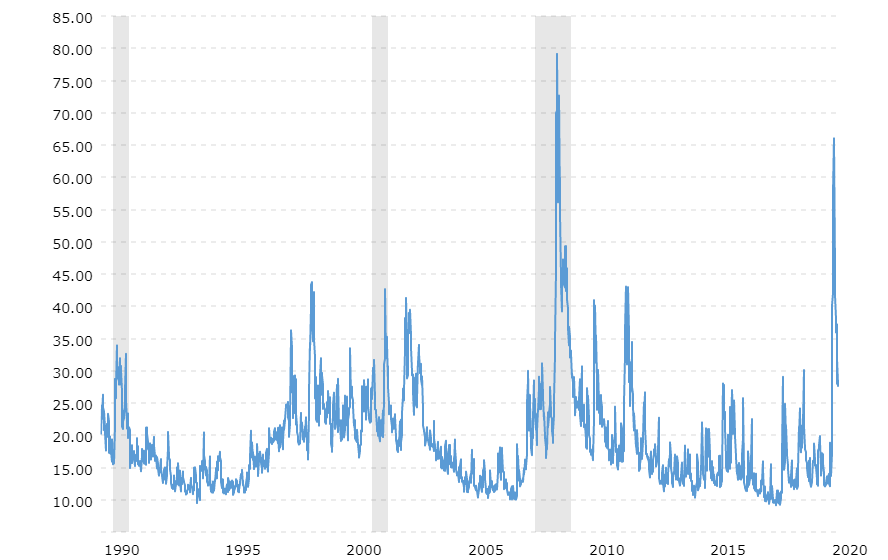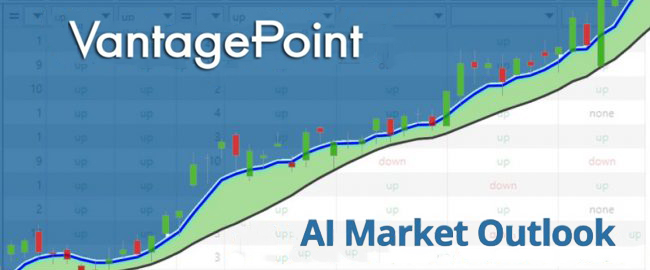Understanding Options: Why Warren Buffet Loves to Sell Puts
The best way to understand Options Trading is to think of the insurance business.
Any insurance contract will insure you for a specific amount of coverage, for a specific amount of time. In exchange for this protection you will be required to pay a premium payment to the insurer.
Since Options are instruments that are only good for a specified period of time, they are considered to be deteriorating assets. All things being equal, an Option will be worth less tomorrow than it is today, simply because it is closer to the expiration date.
An Option is recognized as a deteriorating asset by savvy traders who use this understanding to create strategies that provide additional income to their portfolio while hopefully also minimizing risk.
A buyer of an Option has rights. To receive those rights, they will have to pay a premium payment to the Option seller.
A seller (creator) of an Option has obligations. They will be required to offset their position or fulfill their obligation if the market works against them.
What this means is, you can be the insurer and collect Option premiums in your account. However, before you do so, you need to understand that should the market move adversely, you will be required to either close out your position with a corresponding loss or fulfill the obligation that you created.
Selling Options for income is one of the few strategies where you can be completely wrong about the direction of the market and still win. This is because an Option is a deteriorating asset and the premium will deteriorate exponentially the closer the Option is to the expiration date. By no means does this mean it is not risky. A seller of a put Option is obligating themselves to own the stock at the agreed upon strike price between now and the expiration date.
This time decay of Option premium is best shown through the following chart:
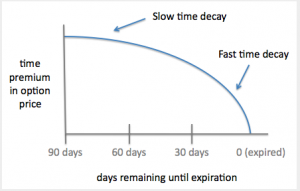
Time Decay of Option Premium
A put Option is a contract that gives the buyer the legal right (but not the obligation) to sell 100 shares of the underlying stock at a pre-determined agreed upon price (strike price) any time on or before the expiration date of the contract, in exchange for the premium that they pay for that Option. The buyer of the Option enjoys limited risk and the most they can lose is the premium they paid for the option.
When you sell a put Option on a stock, you’re selling someone the right, but not the obligation, to make you buy 100 shares of a company at a certain price (called the “strike price”) before a certain date (called the “expiration date”) from them.
Let’s look at all of the components of an Options trade so that we familiarize ourselves with the language, mechanics, and both sides of the Options trade.
For this example, we will use a hypothetical stock called ABC Industries and assume it is trading at $100 a share.
ABC 100 July Put @ $10
ABC is the name of the stock symbol
$100 is the strike price or the agreed upon price that the stock will be purchased at between now and the expiration date.
July is the expiration date.
Put is the type of option. This gives the buyer the right but not the obligation to sell ABC stock at $100 a share.
$10 per share is the premium that the buyer pays to the seller of the Option.
Let’s assume that there are only 10 trading sessions left till the Option’s expiration date.
Based upon these mechanics we can derive some very important trading information to decide whether we should buy, sell or stand aside on this Options trade.
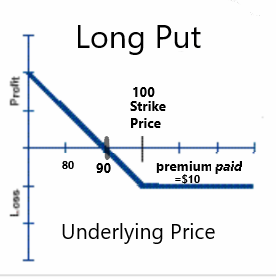
Understanding Long Puts
From this information we can quickly deduce the following for this transaction.
Strike Price – Premium Paid = Break Even for Put Buyer
100 – 10 = 90 is the break even for the buyer of the put
A buyer of this put Option, if they held their Option till expiration would need the underlying stock to be trading underneath $90 per share for them to earn a profit.
If we assume that there are 10 days left till expiration, this amounts to a 10% move in the underlying stock.
This can certainly happen. But a smart Options trader would look at the underlying chart of the stock and see how often the stock has declined 10% in a period of 10 days before deciding how to trade.
At any price above the $100 strike price the option buyer will lose all of their $10 premium.
More importantly, and all things being equal we can assume that the option will deteriorate in price by $1 per day. Once you write a naked put in a cash account, your broker will “set aside” the appropriate amount of cash. You can’t withdraw that cash or use it to buy other securities – even money market funds. This is done to provide collateral for the obligation you created.
So Why Does Warren Love Selling Puts?
Warren Buffett, one of the most successful investors of our time, uses this time-tested strategy to generate income for his portfolio.
Mr. Buffet is famous for being a very long-term investor. His strategies revolve around building a fundamental value for a company. As the company approaches that fundamental valuation level, Mr. Buffet through his Berkshire Hathaway fund will begin selling long term puts on a company, obligating himself to own the underlying shares of the company and collecting premium in the interim.
A graph of selling this put option would look as follows:
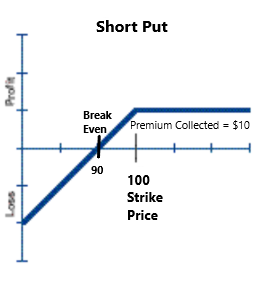
Selling Short Puts
Mr. Buffet’s thought process is that at $100 the company is very fairly valued. If someone is willing to pay him $10 obligating him to buy the company at $100 that means that his break even price on the stock, should he get exercised would be $90 a share. So, he likes it at $100, but at $90 he is acquiring this asset for less than its fair market value and is willing to hold on to it until it becomes overvalued.
While this strategy has proven to be very effective for Mr. Buffet, short term traders apply this same type of thinking but are focused on the expiration date of the contract. Today’s Options expire on many stocks, every week. This means that in an uptrending market, you could sell put Options with a relatively high probability of success. Please remember, that in this hypothetical example, the expiration date is only 10 trading sessions away. Let’s look at the three possible outcomes on this trade.
Possibility #1 – The Stock trades above $100 at expiration. In this scenario, the option seller would keep the entire premium of $10 per share.
Possibility #2 – The Stock trades between $90 and $100 per share at expiration.
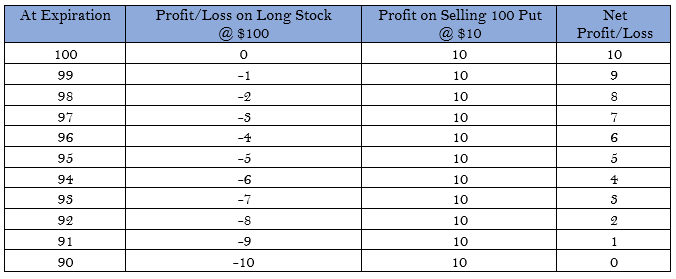
You can clearly see that the stock could selloff 10%, all the way to $90 at expiration before you are at risk for losing money.
Possibility #3 – The Stock trades below $90 per share at expiration.
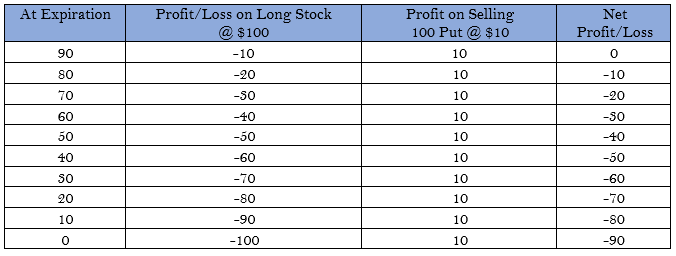
In this third scenario, at any price under 90 at expiration the seller of the put loses money in an equivalent manner as if he was long the stock at $90.
Put Option Sellers in the financial markets can also be focused on applying this type of strategy for very short periods of time to benefit from the decay of the Option premium.
Options premiums will inflate when there is massive fear in the market. This is the nemesis to this trading tactic. To understand this phenomena, imagine that you sell insurance and it is early September 2006. Hurricane Katrina is barreling down on New Orleans. If you are creating the insurance contract for someone, the risk is much higher now than it was in August! So, you would charge significantly more for the obligation to provide someone coverage.
The same is true for the financial markets. When FEAR exists in an asset, the options premiums will rise abruptly. Looking for these instances is when savvy traders increase their chances of success.
Here is a chart of the Volatility Index which is on the Chicago Board Options Exchange. The gray areas on the chart are recessions and contractions in the stock market. Notice how in these instances the Volatility Index which measures FEAR and the variance of future prices jumps very dramatically.
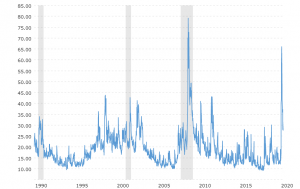
Volatility since 1990
Looking at a chart of the VIX can help you determine for yourself if implied volatility is high or low.
During the peaks in the Volatility Index, Option Premiums spike, often doubling or more, which is the ideal environment for SELLERS of options to collect additional premium and add income to their portfolio.
On many stocks and indexes, option series expire every week. For example, option on the S&P 500 Index (SPY) expire three times a week on Monday, Wednesday and Friday. This availability and liquidity permits Option sellers to capitalize on the time decay of the Option as it approaches expiration. But it is possible to sell PUT Options going out as far as a year or more into the future. When traders do this, they can collect huge amounts of premium to compensate for the coverage they are providing.
This strategy of Selling puts is also very popular in the Commodity Futures markets. In the Commodity markets it is possible to estimate the cost of production for the underlying asset. For example, at present time the estimates are that it costs $17 to mine one ounce of Silver and $1,000 to mine one ounce of Gold. When these markets are approaching these levels, many traders will choose to sell long term put Options and collect premium.
What’s Your Best Chance To Make Money In The Financial Markets Today?
The Answer A.I. offers will surprise you.
Today Artificial Intelligence, Machine Learning and Neural Networks are an absolute necessity in protecting your portfolio. Imagine if you received a forecast that was up to 87.4% accurate about the direction of an underlying stock or Index 3 to 5 days in advance. Would that be valuable to you?
Seeing is believing.
Here is a chart of the S&P Cash Index (SPY):
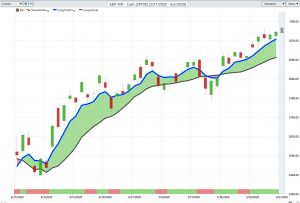
SPY with Vanagepoint a.i. forecasts
Options Expire on the SPY every Monday, Wednesday and Friday.
On this chart if you see GREEN, that means the trend is UP and an ideal environment to sell put Options and collect premium. If you see RED, the forecast is DOWN, and it is an ideal environment to sell call Options.
Remember that ideally you would be selling premium approaching expiration with less than 10 trading sessions left.
Same applies to the following chart of Facebook!
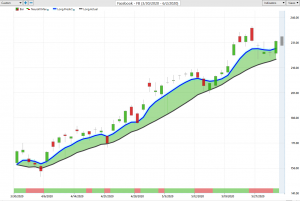
Facebook with Vantagepoint a.i. forecast
Or for any stock or asset that we can apply artificial intelligence, machine learning and neural networks to.
Traders who purchased on the GREEN forecast did quite well, but Put Option Sellers also did extremely well as the market moved away from their strike prices and the premium they collected expired worthless. And they repeated this action again and again since there are weekly options expirations on this stock.
Artificial intelligence is not “a would be nice to have” tool.
It is an “absolutely must have” tool to flourish in today’s global markets.
Over the coming weeks, you can rest assured that Vantagepoint Power Traders will continue to build wealth one trend at a time, even in these volatile conditions.
Trading or investing whether on margin or otherwise carries a high level of risk, and may not be suitable for all persons. Leverage can work against you as well as for you. Before deciding to trade or invest you should carefully consider your investment objectives, level of experience, and ability to tolerate risk. The possibility exists that you could sustain a loss of some or all of your initial investment or even more than your initial investment and therefore you should not invest money that you cannot afford to lose. You should be aware of all the risks associated with trading and investing, and seek advice from an independent financial advisor if you have any doubts. Past performance is not necessarily indicative of future results.
Intrigued? Visit with us and check out the a.i. at our Next Live Training.
Discover why artificial intelligence is the solution professional traders go-to for less risk, more rewards, and guaranteed peace of mind.
It’s not magic. It’s machine learning.
Make it count.





